Maybe there was something in the water. Douglas David Seifert learned to swim at what is now one of the most revered macrophotography destinations in the United States: the Blue Heron Bridge in Riviera Beach, Fla. In the early 1960s Palm Beach County was an absolute paradise; there were very few dive shops and hardly any tourists who were interested in viewing the near-shore underwater world through a facemask. But Seifert’s childhood obsession was doing just that while growing up on Singer Island, Fla. He went deep-sea fishing with his father every weekend and had aquariums at home for which he collected invertebrates and tropical fish. He became a keen observer of fish behavior at an early age.
Although Seifert failed the classroom portion of his first scuba class at age 12 — the math involved in the dive tables was too much for him at the time — later in life he overcompensated and became a scuba instructor, actually teaching the math that had once confounded him. His immersion in the dive industry brought him in contact with one of the early icons of marine conservation in South Florida, Norine Rouse. “Take only pictures, kill only time, leave only bubbles” was her mantra, and Seifert was her protégé. He had great admiration for her, whom he called “this funky, crazy, fearless 60-something-year-old woman running a dive shop.” He recalled that she was not a fan of shark baiting, but at that time there might be 20-30 bull or lemon sharks on a dive even without using bait. This was also a time when any given day diving Palm Beach County would reveal 12–24 turtles, mostly loggerheads. Rouse would dive with a buffing pad, and the turtles would recognize her at a distance and swim right up to her to have their shells cleaned. She had a true rapport with marine life. Her passion for the welfare of marine life was infectious, and helped shape Seifert’s lifelong commitment to conservation issues.
Wanderlust and an ambition to sell TV and movie scripts in Hollywood drove Seifert west. Soon disenchanted with the entertainment industry, he sold everything he owned to buy an around-the-Pacific ticket, back when such things existed. That meant he could go somewhere such as Australia, spend a few weeks (or months) and then hop on another jet to Fiji or wherever. His parents gave him a Nikonos camera system as a going-away gift, though he knew very little about how to use it. While in Sydney, he wandered into the Dive 2000 store and met underwater photographer Kevin Deacon, who fortuitously offered lessons to the uninitiated.
“In the film days, learning underwater photography without instruction was a very slow and unforgiving process,” Seifert recalled. “Kevin accelerated my learning curve, as did a book I read almost daily for four months: Howard Hall’s Guide to Successful Underwater Photography. Howard and I have since become good friends, but I doubt he’ll ever know how meaningful that book was to me at that time in my life.” Deacon’s instruction proved invaluable when Seifert dived with great white sharks at Dangerous Reef, South Australia, guided by the incomparable Rodney Fox. At the time, fewer than 100 people in the world had ever dived with great white sharks.
Some time later, back in Florida, Seifert met Doug Perrine (see Shooter, Fall 2013) and went with him on a trip to the Azores. Armed with a Nikonos RS and a 20-35mm lens, Seifert managed to get some underwater photos of sperm whales at a time when very few such images existed. He showed them to the publishers of Ocean Realm, who happily agreed to publish them along with an article about his adventures in the Azores. At the time Ocean Realm was the most prestigious dive journal, and having his images prominently displayed was momentous. He followed that article with one about manatees and dugongs, which was the cover story for the journal’s issue that debuted at the 1996 Diving Equipment and Marketing Association (DEMA) Show. The underwater photo industry noticed those images in particular, and that marked Seifert’s induction into the fraternity of underwater photojournalism. Also in 1996 Seifert began writing articles for Dive International, a British dive publication (now called DIVE). Today he is DIVE‘s world editor and the writer of a monthly feature called “Water Column.” He has written and photographed roughly 100 features articles.
A hallmark of Seifert’s photography and writing is the exacting research that goes into his projects well in advance of travel. “If I didn’t read and research, I wouldn’t know what I should photograph or recognize the significance of behaviors I might capture,” he said. “I go into the sea thinking I know something about what might happen, but nature consistently delights and delivers much beyond my imagination. I could no more dive without my camera than I could write a worthwhile article without the extensive research I do each time.”
When asked about his favorite camera for underwater use, Seifert replied, “I think of my camera gear like a toolbox. Sometimes I need a Phillip’s head, other times a claw hammer. There is a right tool for each job, and unfortunately there is no photographic Swiss Army knife. It would be more convenient if one manufacturer did everything, but I love the 50-megapixel files of my Canon DSLR, with the beautiful density and ability to crop. They also have my favorite telephotos for topside use. Nikon has a brilliant 60mm macro lens, which is fast and very sharp. Plus, I can use my trusty, 20-year-old Nikonos RS 13mm lens on my Nikon digital camera body by means of a clever adaptation on my Seacam housing. This is my single favorite tool for underwater photography, particularly since I have an overwhelming preference for photographing large marine life such as sharks, whales and manta rays.”
Seifert spends as many as 40 weeks per year on the road these days in pursuit of underwater images. He is usually accompanied by his wife, Emily, who was not a diver when they met but now has logged more than 1,600 dives. Much of this time is spent in support of conservation groups such as Shark Savers, Manta Trust and Global Shark Diving.
“I enjoy what I do, and with every dive I gain greater appreciation for my mentors, who taught me so much about the sea in general, and underwater photography specifically,” he explained. “Chris Newbert, Doug Perrine, Jim Watt, Avi Klapfer and Howard Hall have all been so gracious to me. Ron and Valerie Taylor, Stan Waterman and Eugenie Clark took me in and brought me to another level of adventure and technique in our decades of diving around the world. I hope I can give some back to the next generation.” Despite having had a long and successful career, Seifert has no plans to slow down any time soon. When asked if he ever plans to dial back the travel a little, he readily replied, “I consider Stan Waterman my touchstone, so that means I should have at least another 40 good years in me.”
Read along as Seifert describes some of his favorite images.
The Man in the Gray Overcoat

“I have been fascinated with great white sharks since I saw the movie Blue Water, White Death in the theater as a child, circa 1971. I traveled to South Australia with my first underwater camera to experience these magnificent animals for myself with the consummate shark guide, host and victim: Rodney Fox. I have been diving irregularly but often with great white sharks in South Australia, South Africa and at Guadalupe Island, Mexico, ever since. Only South Australia offers the opportunity to take a cage to the bottom and see the sharks meander through rocky canyons and around the periphery of kelp and seagrass plains. I was struck by how graceful and serene they were when not being teased with baits suspended from floats at the surface. I was mostly outside of the cage when I made this image. The shark was really a lot closer than it appeared in the viewfinder. I tried not to think about that because the scene was just so electrifying and beautiful.”
Night Mantas
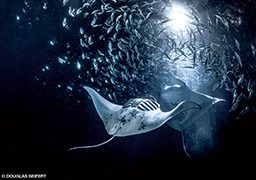
“The manta ray night dive off Kona, Hawaii, is one of the greatest spectacles of the underwater world. It’s accessible to snorkelers and divers of all skill levels, almost every night of the year. The theatricality of the dive is astonishing to witness; it’s a light show with swirling, feeding manta rays, a Cirque du Soleil of the sea. Afterward, when the divers have left, does the show still go on? My team and I spent a few nights with a boat, a generator, and a movie light intending to find out. Of course, where there is food, there are diners. The movie lights provided attraction to lure the copepods to the surface, where the fish gorged themselves, and the mantas did barrel rolls as they fed upon the abundant food. This is a color image made virtually black and white by circumstances, not by processing.”
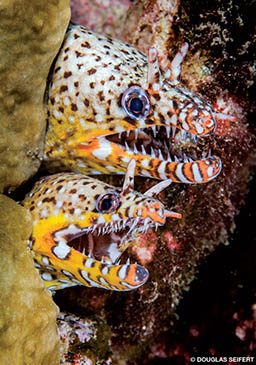
Dragon Morays
“Throughout much of their former range, particularly in Hawaiian waters, dragon moray eels have been commercially overcollected to the extent that they are now quite rare. But dragon morays are not collected in the Marquesas Islands of French Polynesia and are thus more frequently encountered. They are by no means common, but on a recent two-week exploration of the Marquesas I had the great fortune to find two together in the same crevice. This was unbelievably lucky, and I spent the entirety of my dive concentrating upon the pair, paying little attention to the manta ray that swam in lazy circles above my head.”
Love on the Run
“Working under permit in the Kingdom of Tonga, I really wanted to see what goes on in a ‘heat run.’ Be careful what you wish for. A heat run is a behavior in which male humpback whales compete against each other for the favor of a female in estrus, which they are all pursuing at breakneck speed.
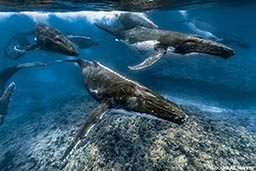
“Jumping in among a group of randy 40-foot-long whales with their intentions alternating between violence and lust is something you don’t want to spend time contemplating. As Ron Taylor always advised me, ‘You’ve got to be in it to win it.’ So I jumped off the stern into the whales’ path. I was overcome by the beauty of the spectacle, and time slowed as it often does in intense situations. To be honest, it was thrilling. To be really honest, it was terrifying. My body floating on the surface was buffeted by cavitation as the whales’ bodies and tail flukes passed, and they headed seaward, continuing their love train, indifferent to the dazed voyeur they left in their wake.”
Marine Iguana
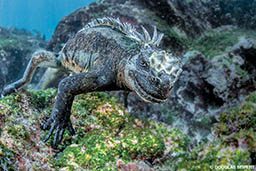
“Only in the Galapagos Islands can marine iguanas be found and only for a short window of time each morning in shallow, near-shore waters with a strong surge and crashing waves over an algae-covered rocky bottom. Underwater photography is most challenging when you’re being pummeled by waves, slammed into rocks and protecting a fragile glass lens port (and less fragile life and limb) while giving the iguana enough space to go about its business. I grew up watching Godzilla movies on television, and if ever there were an opportunity to encounter a pint-sized Godzilla, it exists in Galapagos, though solely at the marine iguana’s whim.”
Coconut Octopus in a Guinness Glass
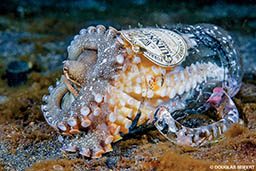
“Every night dive delivers the unexpected, sometimes in weird or funny ways. In Lembeh Strait, Indonesia, we came across a coconut octopus dragging its mobile home — a discarded Guinness glass — across the nondescript muck of one of the dive sites. When caught in the dive torch’s beam, the octopus retreated into the relative safety of the transparent glass, perhaps overlooking the fact that it was hiding in plain sight. Working for a UK dive magazine and having attended staff debriefings in a pub or two, I thought it seemed appropriate, perhaps even destined, for DIVE‘s readership.”
Leaf Scorpionfish by Day and Night
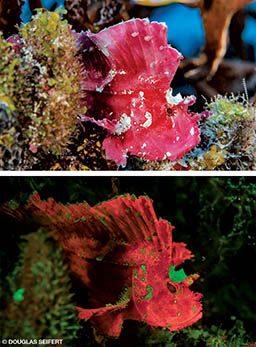
“At one island we visited in Cenderawasih Bay, Indonesia, there was an abundance of leaf scorpionfish (Taenianotus triacanthus), cryptic yet fascinating ambush predators that are often found in pairs or trios. They remain resident at specific coral formations for months or years and can be found in various colorations (for reasons unknown) ranging from pale white to gold to magenta to dark brown. I made the image of a striking magenta specimen on a morning dive and returned to the same reef for our night dive. Instead of using a typical dive light during the night dive, I used Nightsea fluorescence excitation lights and a filter to capture the bioluminescence given off by many coral species as they feed at night. As I shined the blue light of my Nightsea torch into the darkness, the dazzling glow of the same leaf scorpionfish stood out in the darkness from 15 feet away. The orange glow comes from a bioluminescent bacteria associated with the scorpionfish’s skin. A companion leaf scorpionfish, which was brown during the day, gave off no bioluminescent glow by night. The bioluminescent glow is believed to be visible to other fish, but the purpose it serves in unknown.”
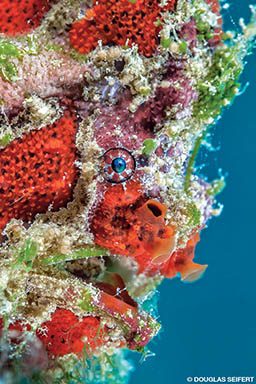
Three-Spot Frogfish
“Masters of camouflage, frogfish play the waiting game, ultimately prevailing as ambush predators par excellence. Their ventral fins are modified for grasping like hands, and they’re content to sit motionless for long periods of time. They use another modified fin that they manipulate to move and wiggle like live bait on a fishing rod, luring a feckless fish within swallowing distance of a cavernous mouth. This three-spot frogfish, photographed in the Philippines, has coloration that blends with the reef and is augmented by algal growth, making detection of the frogfish quite difficult, even for seasoned spotters.”
Snapper Aggregation
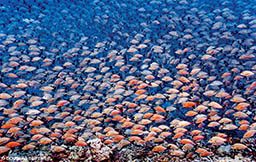
“French Polynesia is one of my favorite places in the world, and my best dives there have consistently been in the Tuamotu Islands. Normally when one thinks of the Tuamotus, one thinks of sharks. Sharks there are (aplenty), but there is so much more. Visiting Rangiroa at different times of the year will reveal different phenomena. In October, the outside reef and Tiputa Pass are filled with a spawning aggregation of humpback snappers (Lutjanus gibbus). The number of fish must reach into the hundreds of thousands if not millions. The reef is barely visible through the mass of fish.”
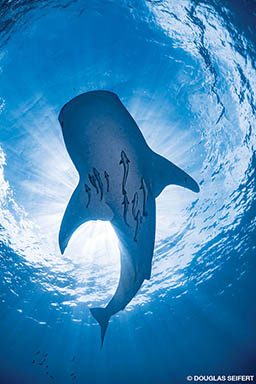
Whale Shark, Cenderawasih Bah, Indonesia
“A whale shark passing overhead allows a different perspective and an opportunity to incorporate the sun and the surface of the sea into the overall mood. In many parts of the world where diving or snorkeling with whale sharks is reliable, authoritarian rule makers have decreed strobe lighting may not be used due to a wholly unsupported pseudoscientific belief, in my opinion, that whale sharks are especially sensitive to lights. I find this one of the truly irritating absurdities of humans’ presumptions about animal welfare. As an ambassador for Global Shark Diving’s alliance, it is my duty to bring educated reason to the public’s and policymakers’ perceptions about the true nature of these sublime animals.”
Leafy Seadragon
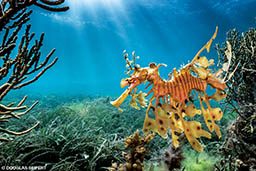
“If an award were given for the animal that looks most like a float in a Mardi Gras parade, the leafy seadragon would have no close second. These unique members of the seahorse family are endlessly fascinating to watch, and they must be watched intently if one is to perceive their appendages among the surrounding kelp and seaweed. The wave-crashed shores of South Australia, where leafy seadragons are found, are dramatic, so in that spirit I framed the animal with wild seagrass and gorgonia forest. I leveraged the strong sunlight, which suggested to me the lighting of an opera — Richard Wagner’s Siegfried in a cosmopolitan theater, perhaps.”
© Alert Diver — Q4 Fall 2016